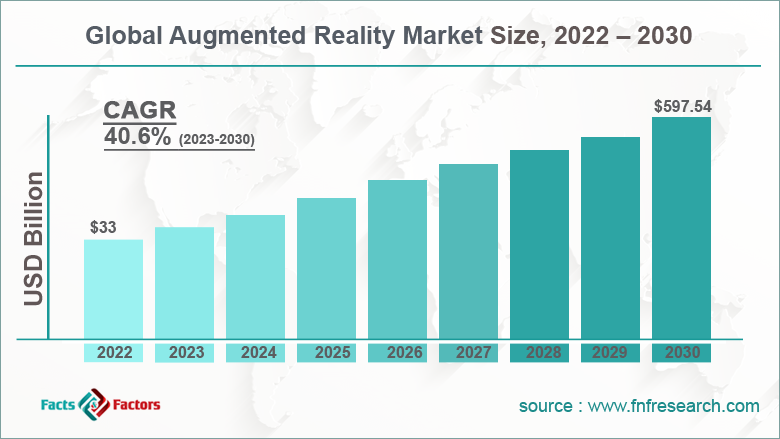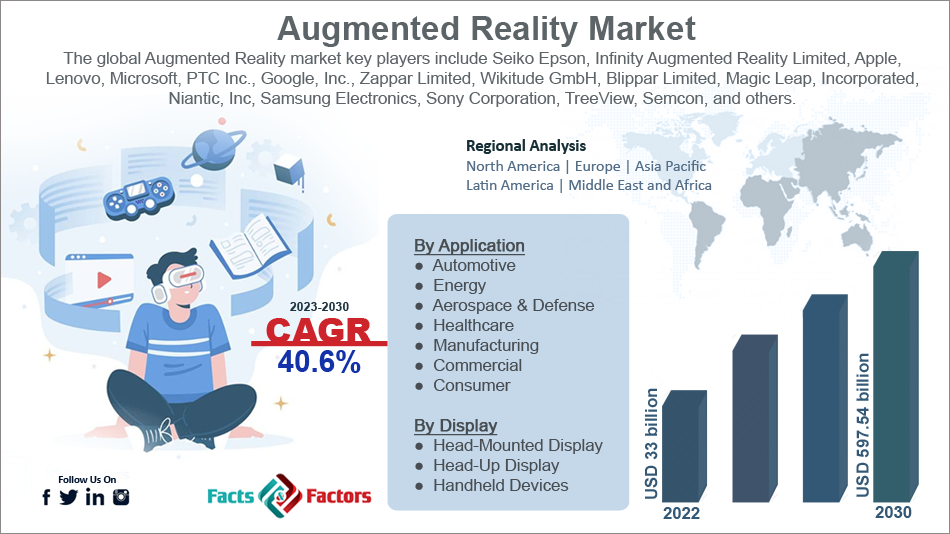Search Market Research Report
Augmented Reality Market Size, Share Global Analysis Report, 2023 – 2030

Augmented Reality Market Size, Share, Growth Analysis Report By Application (Automotive, Energy, Aerospace & Defense, Healthcare, Manufacturing, Commercial, and Consumer,), By Display (Head-Mounted Display & Smart Glass, Head-Up Display, Handheld Devices), Offering (Hardware, Software), By Technology (Anchor-Based AR Technology, Markerless-Based AR Technology, and Marker-Based AR Technology), and By Region - Global and Regional Industry Insights, Overview, Comprehensive Analysis, Trends, Statistical Research, Market Intelligence, Historical Data and Forecast 2023 – 2030
Industry Insights
[230+ Pages Report] According to the report published by Facts and Factors, the global augmented reality market size was valued at USD 33 billion in 2022 and is anticipated to surpass USD 597.54 billion by the end of 2023. The augmented reality market is likely to grow with a significant CAGR of 40.6% during the forecast period. The augmented reality industry report comprehensively analyzes the market's growth factors, barriers, opportunities, and challenges during the forecast period. Also, it further throws light on the investor's and stakeholders' space to help users in the efficient decision-making process.

 Market Overview
Market Overview
Augmented Reality (AR) is the fusion of digital information with the real-world environment. It is able to offer such an immersive experience with various digital visual elements and sensory stimuli through holographic technology. AR includes three features – integration of the physical and digital world, real-time interactions, and precise 3D identification of real & virtual elements. It offers an enhanced way to curate, design, and deliver instructions by overlapping the digital information on the user's environment in real-time. It thereby serves a wide variety of purposes, from assisting in decision-making to entertainment.
 Key Insights
Key Insights
- As per the analysis shared by our research analyst, the global Augmented Reality market is estimated to grow annually at a CAGR of around 40.6% over the forecast period (2023-2030).
- In terms of revenue, the global market size was valued at around USD 33 billion in 2022 and is projected to reach USD 597.45 billion by 2030.
- The high adoption rate of Augmented Reality devices is likely to boost the global market growth.
- Based on the application, the manufacturing segment accounts for the largest share of the global market.
- Based on the device type, the head-mounted display is the fastest-growing segment of the global market.
- Based on the offering, the hardware segment dominates the global market.
- Based on the technology, the anchor-based AR technology segment holds the largest share of the global market.
- Based on region, Asia Pacific is expected to dominate the market during the forecast period.

 Growth Drivers
Growth Drivers
- Surging usages of Augmented Reality devices are likely to fuel the growth of the global market.
The growing number of users of Augmented Reality devices is one of the primary reasons for the exponential growth of the global Augmented Reality market. The high penetration of smartphones has made them a basic necessity for people all across the globe. Additionally, the inclusion of new features and services by the service providers, along with their high availability at economical prices, is the driving force behind the growing demand for Augmented Reality devices.
Furthermore, the fast development of telecom infrastructure and the high disposable income of people is encouraging more people to purchase high-tech smartphones. As a result, the increase in the user base of different hand devices, including tablets and smartphones, is encouraging companies to leverage mobile Augmented Reality technology, which is likely to further accentuate the growth rate of the global Augmented Reality market.
 Restraints
Restraints
- Health issues associated with the high use of Augmented Reality are likely to impede the growth of the global market.
The growing popularity of AR-based games has increased health problems among users. The highly immersive and interactive content engages gamers for long hours, causing various health problems like eye issues, obesity, migraines, anxiety, lack of concentration, etc.
Apart from these, exposure to electromagnetic radiation can cause severe and chronic medical problems. As a result, these factors are likely to hamper the growth of the global Augmented Reality industry.
 Opportunities
Opportunities
- The rapidly growing travel and tourism sector will open new growth opportunities in the global market.
Travel and tourism are one of the fastest-growing industries worldwide. The tourism market works on the information. Therefore, AR plays a crucial role in offering information to users to improve the experience of travelers and tourists. Also, it is used in different cultural institutions to increase the engagement rate of visitors through real-time navigation. It is also used for outdoor applications. Tourists use different handheld devices to point out any physical objects and locations. It allows them to learn and gain knowledge about anything and everything that comes their way.
For instance, if a visitor wants to visit a nearby vegetarian restaurant with 5-star reviews – AR can help this visitor by showing a list of restaurants with said filters. Therefore, it significantly enhances the travel experience of tourists. Thereby offering high ROI to the industry.
 Challenges
Challenges
- Reconfiguration of AR applications on different platforms is the biggest challenge in the global market.
Major applications in AR are built for a particular software program. Hence, not every program can be configured using the same design. Therefore, it requires extra time and effort to customize each software. Also, AR has many limitations related to Android versions, operating systems, programming languages, and platforms.
 Segmentation Analysis
Segmentation Analysis
The global Augmented Reality market can be segmented into application, device type, offering, technology, and region.
On the basis of application, the market can be segmented into automotive, energy, aerospace & defense, healthcare, manufacturing, commercial, consumer, and others. The manufacturing segment is likely to dominate the growth of the global market due to the high use of AR in remote assistance, maintenance, assembly, installation, quality control, training, etc.
On the basis of device type, the augmented reality industry can be segmented into handheld devices, head-up displays, and head-mounted displays. The head-mounted display accounts for the largest share of the global Augmented Reality market due to its high demand.
On the basis of offering, the market can be segmented into software and hardware components. The software component is the fastest growing segment in the global Augmented Reality market to the growing number of apps worldwide.
On the basis of technology, the augmented reality industry can be segmented into anchor-based AR technology, markerless-based AR technology, and marker-based AR technology. The anchor-based AR technology segment holds the largest share of the global Augmented Reality market.
 Recent Developments:
Recent Developments:
- Microsoft, in March 2021, got the contract to supply HoloLens technology from the US Army. It is valued at USD 22 billion. The agreement mentions providing 120,000 AR headsets to the military base.
- Magic Leap collaborated with Google Cloud in January 2021 to offer Magic Leap enterprise solutions to find some new cloud-based, spatial computing solutions on Google Cloud.
- Seiko Epson Corporation, in September 2020, innovated its fourth generation of smart glasses of optical engines. These optical engines upgraded the most advanced optical technology for the company's next generation of smart glasses in the Moverio series.
 Report Scope
Report Scope
Report Attribute |
Details |
Market Size in 2022 |
USD 33 Billion |
Projected Market Size in 2030 |
USD 597.54 Billion |
CAGR Growth Rate |
40.6% CAGR |
Base Year |
2022 |
Forecast Years |
2023-2030 |
Key Market Players |
Seiko Epson, Infinity Augmented Reality Limited, Apple, Lenovo, Microsoft, PTC Inc., Google Inc., Zappar Limited, Wikitude GmbH, Blippar Limited, Magic Leap, Incorporated, Niantic Inc, Samsung Electronics, Sony Corporation, TreeView, Semcon, and others. |
Key Segment |
By Application, Display, Offering, Technology, and Region |
Major Regions Covered |
North America, Europe, Asia Pacific, Latin America, and the Middle East &, Africa |
Purchase Options |
Request customized purchase options to meet your research needs. Explore purchase options |
 Regional Analysis
Regional Analysis
- Asia Pacific is likely to dominate the growth of the global market.
Asia Pacific is the fastest-growing region in the global augmented reality market with a high CAGR during the forecast period due to the expanding manufacturing segment in developing areas like Japan, China, and India. The fast-developing gaming industry is further likely to support the positive growth trajectory of the regional market. The expanding healthcare and automotive sectors owing to the growing per capita income of the people are paving the way for upgrading AR technology in the region.
North America is expected to grow exponentially during the forecast period due to the growing technological advancement and presence of leading tech firms in the region.
 Competitive Analysis
Competitive Analysis
- Seiko Epson
- Infinity Augmented Reality Limited
- Apple
- Lenovo
- Microsoft
- PTC Inc.
- Google Inc.
- Zappar Limited
- Wikitude GmbH
- Blippar Limited
- Magic Leap
- Incorporated
- Niantic Inc
- Samsung Electronics
- Sony Corporation
- TreeView
- Semcon
The global Augmented Reality market is segmented as follows:
 By Application Segment Analysis
By Application Segment Analysis
- Automotive
- Energy
- Aerospace & Defense
- Healthcare
- Manufacturing
- Commercial
- Consumer
 By Display Segment Analysis
By Display Segment Analysis
- Head-Mounted Display
- Head-Up Display
- Handheld Devices
 Offering Segment Analysis
Offering Segment Analysis
- Hardware
- Software
 By Technology Segment Analysis
By Technology Segment Analysis
- Anchor-Based AR Technology
- Markerless-Based AR Technology
- Marker-Based AR Technology
 By Regional Segment Analysis
By Regional Segment Analysis
- North America
- The U.S.
- Canada
- Mexico
- Europe
- France
- The UK
- Spain
- Germany
- Italy
- Nordic Countries
- Denmark
- Sweden
- Norway
- Benelux Union
- Belgium
- The Netherlands
- Luxembourg
- Rest of Europe
- Asia Pacific
- China
- Japan
- India
- Australia
- South Korea
- Southeast Asia
- Indonesia
- Thailand
- Malaysia
- Singapore
- Rest of Southeast Asia
- Rest of Asia Pacific
- The Middle East & Africa
- Saudi Arabia
- UAE
- Egypt
- South Africa
- Rest of the Middle East & Africa
- Latin America
- Brazil
- Argentina
- Rest of Latin America
Industry Major Market Players
- Seiko Epson
- Infinity Augmented Reality Limited
- Apple
- Lenovo
- Microsoft
- PTC Inc.
- Google Inc.
- Zappar Limited
- Wikitude GmbH
- Blippar Limited
- Magic Leap
- Incorporated
- Niantic Inc
- Samsung Electronics
- Sony Corporation
- TreeView
- Semcon
Frequently Asked Questions

Copyright © 2024 - 2025, All Rights Reserved, Facts and Factors


